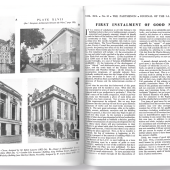Approaches and Perspectives on Alternative Uses of Agricultural Wastes in Construction Materials
Written by Yap Soon Poh, Loginy Loganathan, and Lau Beng Fye
Department of Civil Engineering, Faculty of Engineering, Universiti Malaya (UM), Kuala Lumpur, Malaysia, and Institute of Biological Sciences, Faculty of Science, Universiti Malaya (UM), Kuala Lumpur, Malaysia.
Abstract
In Malaysia, agricultural wastes posted environmental nuisances in the plantation industry without proper disposal methodology, for years. The goal of this study is to summarize alternative outlets for agricultural wastes, particularly on palm oil and mushroom wastes, as well as to investigate the effectiveness of recycling them as concrete materials. Palm oil wastes include oil palm shell and palm oil clinker had been researched extensively in the past decade while the spent mushroom substrate is gaining its research interest. Thus, this study reviews on the uses of oil palm shell, palm oil clinker and spent mushroom substrate as (i) cement and (ii) aggregates substitutions. Performance assessments such as physical properties, workability and strengths will be compared in this study. In addition, the actual applications of selected concrete are also reported.
1. Introduction
17 Sustainable Development Goals (SDGs), had been adopted by all United Nations Member States, including Malaysia in 2015 as a universal call for action to end poverty, to protect the planet and to ensure that all people enjoy peace and prosperity by 2030. In the SDGs, we have to ensure all developments balanced in all social, economic and environmental impacts. Among all the main targeted areas, agriculture plays an important role in achieving all SDGs. To achieve that, the concept of sustainable agriculture development gives priority to environmental considerations, economic development and social needs in the process of crop production. This process involves crop management up to the post-harvest stage, where agricultural wastes need to be managed in an environmentally friendly manner. In regards to waste management of agricultural industry, particular attention had been emphasized on SDG6 (clean water and sanitation), SDG12 (responsible consumption and production), SDG14 (life below water) and SDG15 (life on land), due to the fact that improper handling of agricultural wastes posted heavy impacts on the environment (water and land). Although agricultural wastes are organic in nature and compostable, but they can contain pollutants such as Al3+, Fe2+, PO 3-, NO etc., from the applications of fertilizers and nutrients [1]. Hence the 4x agricultural waste management had been identified as one of the challenges in realization of sustainable agricultural industry. Meanwhile, concrete has emerged as the highest greenhouse gases contributor in the world. Manufacturing of concrete materials including cement and aggregates, has been reported to contribute approximately 8% to global CO2 emissions and this value is larger than global emission from automobiles [2]. In-line with the SDG, construction industry is urged to improve the effort to reduce the carbon emission from the concrete production. For the past decades, industrial by-products with cementitious properties have been continuously explored and utilized as supplementary cementitious materials for the building materials industry to reduce the use of conventional concrete materials. In recent market, slag, silica fume and fly ash had been widely used in blended cement with reduced carbon footprint. In order to solve the mentioned challenges in both agricultural and construction industries, various research has been conducted on recycling agricultural wastes as cement and aggregate substitutions in concrete. However, the feasibility of these agricultural wastes replacements is curbed due to the lack of understanding on the details of these wastes including availability, properties and applications. Therefore, this paper aims to review the potential applications of agricultural wastes into concrete in Malaysia, particularly on the palm oil and mushroom industries, with the target to widen the applications of agricultural wastes in concrete, in the effort to reduce the environmental nuisances from both agricultural and construction activities.
2. Palm Oil Wastes
The reason to review the feasibility of palm oil wastes in concrete is attributed to the huge palm oil waste generation, as Malaysia is the second largest palm oil plantation country. This section will review of the utilizations of different palm oil wastes such as oil palm shell (OPS), palm oil clinker (POC) and palm oil fuel ash (POFA) in the last decade.
Oil palm shell (OPS)
From Table 1, in 2010, a total of 4.32 million tonnes of oil palm shell (OPS) was produced as waste materials, while an average >7 million tonnes of OPS was produced in the year of 2018 and 2019 but dropped drastically to 4.95 million tonnes in 2020 due to the Covid-19 pandemic (MPOB, 2021). In the early practice (before 2000), palm oil wastes include OPS and fresh fruit bunches (FFB) were disposed by uncontrolled dumping which eventually caused environmental pollution. The OPS (Figure 1) as a post-extraction residue contains high amount of lipids content which potentially pollutes the water sources. Utilization of these wastes into potential materials in the production of concrete helps to reduce pollution as well as reduces the requirements to monitor the dumping sites.
Table 1: Generation of oil palm shell (OPS) and fresh fruit bunch (FFB) in Malaysia (MPOB, 2021).
Figure 1: Comparison of oil palm shell and granite aggregates [4]
The history of oil palm shell research can be traced back to Abdullah (1984) who was the first to incorporate OPS into concrete to produce lightweight concrete (LWC). As seen from Figure 1, the distinguished features of OPS (i) its lower specific gravity of 1.37, relative to 2.65 of that granite aggregates and (ii) smooth and concave/convex surfaces of OPS (Figure 1a). This resulted in the density and compressive strength of about 1800–1960 kg/m3 and 14–39 MPa, respectively by using OPS as full replacement for coarse aggregate [4]. Mannan & Ganapathy [5] reported that the long-term behaviour of OPS concrete is comparable to normal aggregate concrete without strength deterioration despite the organic characteristics of OPS. Most of the researches on OPS in concrete were focused between the year of 2010-2015, but focus on performance enhancement of OPS concrete, for example use of supplementary cementitious materials [6], OPS processing [7], and the use of fibre reinforcement [4]. In details, Alengaram et al. [6] incorporated silica fume into OPS concrete and increased the 28-days compressive strength to 36-38 MPa. Meanwhile Shafigh et al. [7] enhanced the strength of OPS concrete of 28-days compressive strength to 53MPa by using crushed OPS. Also, Yap et al. [4] reported significant improvement in structural behaviours (torsion and flexural) in OPS concrete reinforced with steel fibres.
However, the research on OPS concrete was eased after the year of 2015, due to the following reasons:
• The durability properties of OPS concrete are questionable as OPS is organic and has high water absorption. Limited studies on the durability properties of OPS are available.
• Malaysian Palm Oil Board (MPOB) recommended the use of oil palm as fuel materials in the boilers which gains better environmental and economical returns.
Palm oil clinker (POC)
Along with OPS, other palm oil biomass such as fresh fruit bunch and palm fibres are being combusted as fuel materials in the clinker for palm oil extraction. As a result of this, palm oil clinker (POC) as shown in Figure 2(b) are being produced in chunk form, as a residual waste at the bottom of the boilers [8]. POC is considered as a lightweight aggregate (specific gravity 1.69-1.90) [9] because of its porous surfaces, and the shape of POC is irregular and flaky and has rough and spiky broken edges. Relative to the organic nature of OPS, POC is relatively inert and stable attributed to the low loss on ignition (LOI) after the boiler burning process.
Past researches had proven that POC are potential substitutions of aggregates (coarse and fine) and cement, attributed to the low aggregates crushing value and high content of (SiO2 + Al2O3 + Fe2O3) [9].
Figure 2: (a) dumping and burning of palm oil biomass; (b) palm oil clinker in chuck form; (c) crushing process; (d) palm oil clinker in coarse aggregate form; (e) palm oil clinker in fine aggregate form; (f) ball milling process; (g) palm oil clinker powder for cement replacement [8]
As seen from Figure 2, palm oil clinker can be crushed and ground into different sizes to fit its applications of coarse aggregate (Figure 2d), fine aggregate (Figure 2e) and cement (Figure 2g) replacements. The selected researches on POC for different applications are summarized below.
- Mohammad et al. [10] reported the feasibility of producing structural lightweight POC concrete with 18% density reduction, compared to normal concrete.
- Ibrahim et al. [11] documented the design of POC pervious concrete with >80% of waste recycling rate.
- Kanadasan et al. [12] concluded that full substitutions of fine aggregates with fine POC resulted in 78% reduction in compressive strength, however, the fresh properties of POC concrete were improved. In addition, the use of both coarse and fine POC and chemical admixture enabled the mixing of self-compacting concrete with improved flow ability.
- When the palm oil clinker was intended to be used as cement replacement, the chemical compositions of POCP did not match the ordinary Portland cement (OPC) [9]. For instance, SiO2 and CaO content of POC are 60-74% and 3-17%, compared to the values of 17% and 68% in OPC. The low content of CaO in POCP resulted in poor pozzolanic reactivity of POCP. Therefore, POCP is recommended as filler of up to 20% cement replacement level [9].
- In latter research, Nayaka et al. [8] incorporated hydrated lime with high amount of CaO to be blended with POCP, to fully replace OPC in the production of geopolymer. It was reported that incorporation of 40% POCP could reduce the carbon footprint and cost by 32% and 20%, respectively.
- Other than concrete, POC aggregates were also being studied in development of green asphalt concrete [13], at which the asphaltic concrete with full replacement of fine aggregates by POC fulfilled the specification requirements of pavement design.
- Due to the porous nature, POC aggregates were investigated as the substrate medium for bacterial filter systems [14]. It was shown that the removal ability of organic containment was reached by 90% to 95% while the use of POC aggregates posted lower production cost.
Palm oil fuel ash (POFA)
Compared to the POC, palm oil fuel ash (POFA) is a reactive pozzolanic material with high potential for use as a partial replacement for cement in concrete, which generated from the combustion of palm oil biomass wastes in the boilers (Figure 3) [15]. For every 100 tonnes of fresh fruit bunches processed, approximate 20 tonnes of nut shells, 7 tonnes of fibres, and 25 tonnes of empty bunches are discharged from the mill. For every 100 tonnes of palm oil biomass burnt in the steam boiler, approximately 5 tonnes of ash is being produced [16] and this means that about 75 million tonnes of POFA was generated as waste in Malaysia (Table 1). The significant feature of POFA is that it contains 47-70% of SiO2, and 6-14% of CaO and this made POFA a reactive pozzolan and a good substitution of cement up to 30%. In general, the mechanical performance of concrete incorporating POFA depends on the fineness of the POFA and amount of cement replacement [15,17]
In the early research on POFA, Tangchirapat et al. showed that partial replacement of Portland cement (10-30%) by ground POFA (Figure 3b) showed the feasibility of 20% replacement by POFA to produce 90-day compressive strength as high as 70MPa. Also, concrete with POFA showed other advantages including reduction of water permeability, better sulphate resistance and smaller degree of expansion [17]. However, the latter researches are mainly focused on the enhancement of POFA properties such as nanofication of POFA sizes and preparation methods (burning temperature, grinding time etc.) in different applications. The researches on POFA applications were widened in self-compacting concrete, high strength concrete, high performance concrete, lightweight concrete, geopolymer and others.
Figure 3: (a) Palm oil fuel ash (POFA) from factory; (b) ground POFA [15]
Mushroom Wastes
According to Malaysian Department of Agricultural, Malaysia yielded 5,589.1 million tonnes of mushroom in 2018 and the rate is growing by 10-25% per year due to high global demand [18]. For each 1 kg of mushroom grew, at least 4 kgs of Spent Mushroom Substrate (SMS) was produced as wastes (Figure 4) [19]. This means that at least 20000 million tonnes of SMS is produced annually. The necessity to look serious into the mushroom waste management is strengthened by the management methods. According to the study from Romiza, Juliana & Mimi [18], the conventional methods to take care of SMS are summarized in Table 2. It can be concluded that majority of the farmers in Malaysia used non-environmental friendly methods to handle the SMS, which will results in following pollutions, and they are against the effort towards sustainability agricultural industry:
- Open burning will be resulted in hazardous gases from burning of plastic sheets which we used to wrap SMS. The burning of plastics releases toxic gases like dioxins, furans, mercury and polychlorinated biphenyls (better known as BCPs) into the atmosphere, and poses a threat to vegetation, and human and animal health
- For open space dumping, the decomposition of SMS will result in runoff that contains not only aluminum and iron precipitates, but also phosphorous and nitrogen, which are major sources of pollution in lakes and streams, as well as underground water.
- The plastic wrappers of SMS might end up in rivers/seas if dumped into river directly (Table 2).
Table 2: Conventional mushroom waste management methods in Malaysia [18]
Figure 4: (a) Stacks of mushroom substrate and (b) dumping of spent mushroom substrate
Table 3 summarizes the available technology on the mushroom waste management. The most
common technique is decomposition of SMS into fertilizer, poultry’s food, soil stabilizer or even food enzyme [20,21]. Different methods are available which including normal decomposing, and vermicomposting using worms etc. Also, SMS is rich in which consists of cellulose, hemicellulose, lignin, pectin and polysaccharides. These compounds are essential nutrients for other plantations such as sugar cane and hence studies [22] suggesting the reuse of SMS for other plantations. In addition to them, researchers like Landschoot & McNitt [23] also suggesting that we can rejuvenate the nutrients into used SMS to make it to be reusable as substrate for multiple growing of the same mushroom species. More than that, SMS can be burnt to generate power and acts as alternative fuel materials [24]. However, most of the methods are not being commonly practiced in Malaysia, as reported in Table 2. The disadvantages of each methods are being summarized in Table 3. There is a necessity to develop SMS management techniques which do not possess the above-mentioned disadvantages. Therefore, this paper also presented the preliminary results on recycling mushroom wastes (SMS) as fine aggregate replacement into concrete mortar. The SMS is dried and ground to the size between 1.25-5mm as shown in Figure 5, with a specific gravity of 0.2. The mix design of the concrete mortar is according to ASTM C1713 – 17. Table 4 showed the compressive and flexural strengths of concrete mortar incorporating with 0-10% SMS. From the results, it was shown that the highest compressive and flexural strengths were observed in the mix with 5% SMS, with about 10% improvements in both compressive and flexural strengths, along with 4% density reduction compared to the control mix. However, the strengths reduced drastically when the SMS replacement was increased to 10%.
Table 3: Current techniques available for environmental friendly SMS handling
Figure 5: Processing of Spent mushroom substrate (SMS) as fine aggregates
Table 4: Preliminary of concrete mortar with spent mushroom substrate
Applications of Agricultural Wastes in Concrete
As mentioned previously, the acceptance level of agricultural wastes is limited and the scenario can be related to the reasons: (i) concerns on the durability of concrete made from agricultural wastes caused by the organic residues within the wastes, as organic compounds are susceptible to degradations; (ii) there is a lack of durability studies on actual structures of agricultural wastes concrete. Hence, there are few case studies where the researchers constructed the structures and conduct durability testing/observations on the structure, as shown in Figure 6, 7 and 8. Figure 6 showed three different structures made from oil palm shells, consist of footbridge (Figure 6a), low cost house (Figure 6b) [25] and gazebo (Figure 6) [26]. All these structures are being monitored for the long-term behaviours. Meanwhile, there is another study published on the application of oil palm shell concrete as blast resistant structure [27]. Figure 7 showed the comparison of normal concrete and oil palm shell fibre-reinforced concrete under 10kg blast loading. It was shown that oil palm shell gave higher ductility and energy absorption capacity under blast loading and further widen the applications of OPS as blast resistant structure. Meanwhile, Figure 8 showed another low-cost house fabricated using palm oil clinker, in Malaysia, and it is currently under long term observations on the structural stability and energy efficiency.
Figure 6: (a) Footbridge [25]; (b) low cost house [25] and (c) gazebo [26] made from oil palm shell.
Figure 7: (a) normal concrete and (b) oil palm shell fibre-reinforced concrete slabs after 10kg blast loading [27]
Figure 8: Low cost house made with palm oil clinker-lime masonry mortar [8]
On the other hand, to date, there are no structural applications on both POFA and SMS. There is a necessity for more durability studies to be conducted in order to increase the acceptance of POFA and SMS as construction materials.
Conclusions
This paper reviews four agricultural wastes, named oil palm shell (OPS), palm oil clinker (POC), palm oil fuel ash (POFA) and spent mushroom substrate (SMS), as concrete material substitutions in Malaysia. Further conclusions were drawn:
i. The acceptance level of agricultural wastes in concrete is relatively lower due to their organic origin.
ii. POC can be processed into different sizes to be utilized as cement, coarse and fine aggregates substitutions.
iii. The pozzolanic POFA is a good candidate to replace cement up to 30% with lower carbon footprint and it is more cost effective.
iv. Spent mushroom substrate is a potential candidate as fine aggregate alternative.
v. Few actual applications of oil palm shell and palm oil clinker which are undergoing long term observations, had been discussed.
Acknowledgment
This study is supported by Universiti Malaya Impact Oriented Interdisciplinary Research Grant (IIRG)- A Sustainable Circular Economy Approach Towards Smart Mushroom Waste Management, under the sub programme Green and Cooling Infrastructures from Recycled and Reformed Mushroom Wastes (Project code: IIRG004B-2020IISS).
References
1. Miles, P. G., & Chang, S. T. Mushrooms: Cultivation, Nutritional Value, Medicinal Effect, and Environmental Impact: CRC Press, 2004.
2. R. M. Andrew. Global CO2 emissions from cement production, 1928–2018. Earth System Science Data Discussions, 2019, 11: pp. 1675-1710.
3. Abdullah, A.A. Basic strength properties of lightweight concrete using agricultural wastes as aggregates, Proceedings of International Conference on Low-cost Housing for Developing Countries, Roorkee, India, 1984.
4. Yap, S. P., Khaw, K. R., Alengaram, U. J. & Zamin, M. Z. Effect of fibre aspect ratio on the torsional behaviour of steel fibre-reinforced normal weight concrete and lightweight concrete. Engineering Structures, 2015, 101: 24-33.
5. Mannan, M. A. & Ganapathy, C. Long-term strengths of concrete with oil palm shell as coarse aggregate. Cement and Concrete Research, 2001, 31: 1319-1321
6. Alengaram, U. J., Mahmud, H. & Jumaat, M. Z. Comparison of mechanical and bond properties of oil palm kernel shell concrete with normal weight concrete. International Journal of the Physical Sciences, 2010, 5(8): 1231-1239
7. Shafigh, P., Jummat, M. H., Mahmud, H. & Alengaram, U. J. A new method of producing high strength oil palm shell lightweight concrete. Materials and Design, 2011, 32(10): 4839-4843.
8. Nayaka, R. R., Alengaram, U. J., Jumaat, M. Z., Yusoff, S. & Alnahhal, M. F. High volume cement replacement by environmental friendly industrial by-product palm oil clinker powder in cement e lime masonry mortar. Journal of Cleaner Production, 2018, 190: 272-284.
9. Hamada, H. M., Jokhio, G. A., Al-Attar, A. A., Yahaya, F. M., Muthusamu, K., Hamada, A. M. & Gul, Y. The use of palm oil clinker as a sustainable construction material: A review. Cement and Concrete Composites, 2020, 106: 103447.
10. Mohammed, B.S., Al-Ganad, M.A. & Abdullahi, M. Analytical and experimental studies on composite slabs utilising palm oil clinker concrete, Construction and Building Materials, 2011, 25: 3550–3560.
11. Ibrahim, H.A. & Razak, H.A. Effect of palm oil clinker incorporation on properties of pervious concrete, , Construction and Building Materials, 2016, 115: 70–77.
12. Kanadasan, J., Razak, H. A. & Subramaniam, V. Properties of high flowable mortar containing high volume palm oil clinker (POC) fine for eco-friendly construction, Journal of Cleaner Production, 2018, 170: 1244– 1259.
13. Babalghaith, A. M., Koting, S., Sulong, N. H. R., Karim, M. R., Mohammed, S. A. & Ibrahim, M. R. Effect of Palm Oil Clinker (POC) Aggregate on the Mechanical Properties of Stone Mastic Asphalt (SMA) Mixtures. Sustainability, 2020, 12(7): 2716
14. Al-dhawi, B. N. S., Kutty, S. R. M., Almahbashi, N. M. Y. Noor, A. & Jagaba, A. H. Organics Removal From Domestic Wastewater Utilizing Palm Oil Clinker (POC) Media In A Submerged Attached Growth Systems, International Journal of Civil Engineering and Technology, 2020, 11(6): 1-7.
15. Ayub, M., Othman, M. H. D., Khan, I. U., Hubadillah, S. K., Kurniawan, T. A., Ismail, A. F., Rahman, M.
A. & Jaafar, J. Promoting sustainable cleaner production paradigms in palm oil fuel ash as an eco-friendly cementitious material: A critical analysis. Journal of Cleaner Production, 2021, 295: 126296.
16. Tay, J. H. & Show, K. Y. Use of ash derived from oil-palm waste incineration as a cement replacement material. Resources, Conservation and Recycling, 1995, 13: 27-36.
17. Tangchirapat, W., Jaturapitakkul, C. & Chindaprasirt, P. Use of palm oil fuel ash as a supplementary cementitious material for producing high-strength concrete. Construction and Building Materials, 2009, 23: 2641-2646
18. Rosmiza M.Z., and Juliana Mah Hussin, and Mimi Halida Ghazali. Pengetahuan agripreneur terhadap potensi sisa substrat cendawan dan kaedah pengurusan lepas tuai tanaman cendawan. Geografia : Malaysian Journal of Society and Space, 2019, 15 (3):. pp. 148-162.
19. Phan, C.W., & Sabaratnam, V. Potential uses of spent mushroom substrate and its associated lignocellulosic nzymes. Applied Microbiology and Biotechnology, 2012, 96: 863-873.
20. Ahlawat, O.P., & Sagar, M.P. Management of spent mushroom substrate. National Research Centre for Mushroom, Indian Council of Agricultural Research, 2007.
21. Grimm, D., & Wösten, H.A.B. Mushroom cultivation in the circular economy. Applied Microbiology and Biotechnology, 2018, 102: 7795-7803.
22. Ashrafi, R., Mianm, M.H., Rahman, M.M., & Jahiruddin. Recycling of spent mushroom substrate for the production of oyster mushroom. Research in Biotechnology, 2014, 5(2): 13-21.
23. Landschoot, P., & McNitt, A. (2019). Spent mushroom substrate as a soil amendment in turf. Retrieved from https:// extension.psu.edu
24. Finney, K.N., Ryu, C., Sharifi, V.N., Swithenbank, J. The reuse of spent mushroom compost and coal tailings for energy recovery: Comparison of thermal treatment technologies. Bioresour Technol, 2009, 100: 310- 315
25. Teo, D. C. L., Mannan, M. A. & Kurian V. J. Structural Concrete Using Oil Palm Shell (OPS) as Lightweight Aggregate, Turkish Journal of Engineering and Environmental Sciences, 2006, 300(4): 251-257.
26. Jalam, U. A., Jalam, A. A. & Ali, D. Characteristics of Concrete Using Oil Palm Shell as Lightweight Aggregate and Ashment as Binder, International Journal of Advancements in Research & Technology, 2016, 5(7): 1-7.
27. Alengaram, U. J., Mohottige, N. H. W., Wu, C., Jumaat, M. Z., Yap, S. P. & Wang, Z. Response of oil palm shell concrete slabs subjected to quasi-static and blast loads, Construction and Building Materials, 2016, 116: 391-402.
Authors Biography
Dr. Yap Soon Poh is a Senior Lecturer at the Department of Civil Engineering in Faculty of Engineering, Universiti Malaya. Dr. Yap possess a PhD degree in Civil and Structural Engineering from the Faculty of the Engineering, Universiti Malaya He has teaching experience in the specialization of concrete and civil engineering materials, structural designs, structural analysis, and engineering mechanics His current research interests are on green concrete, construction and agricultural wastes recycling, special concrete, and energy-efficient structural member development. His current research interests are on development of green pervious concrete, construction and agricultural wastes recycling in concrete composites and micro mechanics characterization of civil engineering materials.
Loginy Loganathan is a postgraduate researcher at Department of Civil Engineering in Universiti Malaya. She obtained her Bachelor of Engineering (Civil) from Universiti Malaya in the year 2019. She is currently pursuing her Master of Engineering Science at Department of Civil Engineering, Universiti Malaya. Her current research interests focus on green building materials, recycling agricultural wastes in concrete composites, fine aggregate replacement, and blended cement.
Lau Beng Fye graduated from the University of Malaya in 2009 with a Bachelor of Science (Biotechnology) degree. He then obtained his Ph.D. in Biotechnology from the same university. He first joined the Institute of Biological Sciences in 2006 as a Postdoctoral Researcher and is currently a Senior Lecturer in the department. His research interest lies primarily in the area of mushroom biology and biotechnology, covering a broad range of aspect including cultivation, fermentation, as well as the chemistry of fungal bioactive compounds and their mechanisms of action. At the same time, he is actively exploring the field of bioremediation and green chemistry.
This research paper was presented at the 2021 CABE Malaysia Chapter online Conference.







